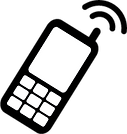PART II: MOBILE APPLICATIONS
All mobile apps fall into three categories: Consumer mobility apps, enterprise mobility apps and apps that straddle the fence between these two kinds.
The vast majority of apps on the various App Stores such as Apple's App Store and Google Play Store fall into the first bucket. Consumer apps are ones that people like you and I download purely for personal use. Apps such as Shazam, Angry Birds, Pandora & Instagram fall into this category. So does the mobile banking app that we use to do banking on the go.
At the other end of the spectrum are apps that are created exclusively for business use. These apps are used by an organization’s employees or partners to carry out day-to-day business activities such as managing inventory at the warehouse, booking orders, servicing customers on the field etc. The mobile app that the courier delivery guy uses at your doorstop to record the delivery of your package, is a classic example of an enterprise mobility app. Another example is a portable ECG app used by a paramedic who is responding to an Emergency Medical Services (EMS) call from someone who is experiencing heart attack symptoms.
The third category of apps is what I call as dual use apps. This is one of the fastest growing category of mobile apps. Many of the apps falling into this category started life as a pure consumer app and then quickly began to be used for work or business use. An example is Tinder which started as a dating app but is now also used by businesses as a means for developing contacts. Then there are other dual use apps such as GMail, Twitter, FB app, Microsoft Office apps etc. where the underlying application has always been used for both business and personal use.
In this part of the book, we begin by diving into the enticing world of consumer mobile apps. This is an area where most apps have failed to even be noticed by users, while the few ones who have succeeded have brought millions to their creators.
In the first two chapters we primarily look at what it means to have a really, really good consumer mobile app.
Most importantly we will take a shot at answering the very difficult question of what it takes to make some mobile apps insanely successful, and their creators fantastically rich, while most others bite the dust.
In the last chapter of this part of the book, we will get into the different business models that drive the consumer apps business and also take a look at the ones used by the successful app development companies.
